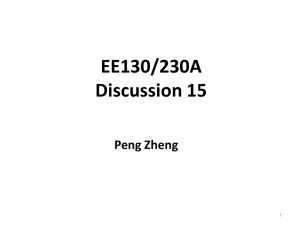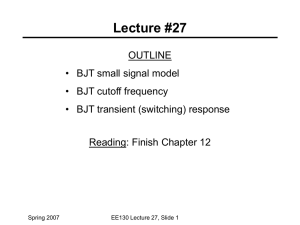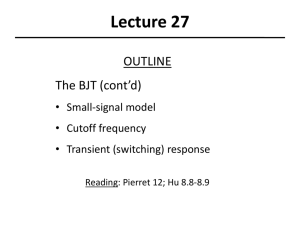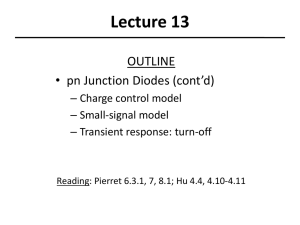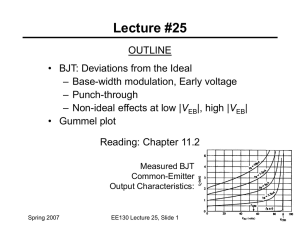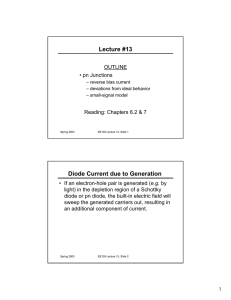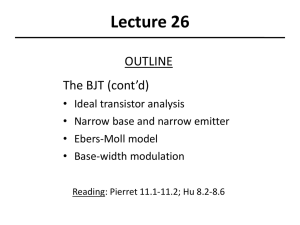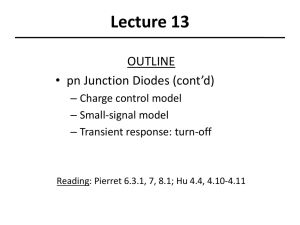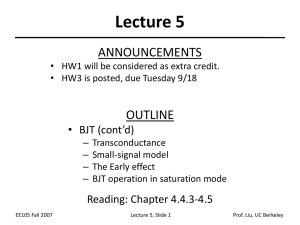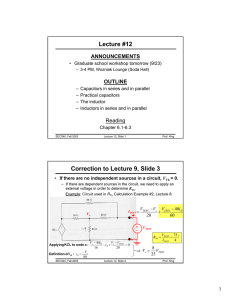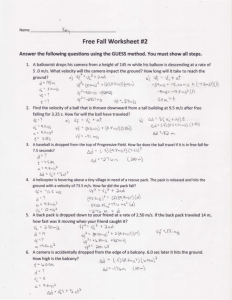Lecture 28 OUTLINE The BJT (cont’d) • Small-signal model
advertisement
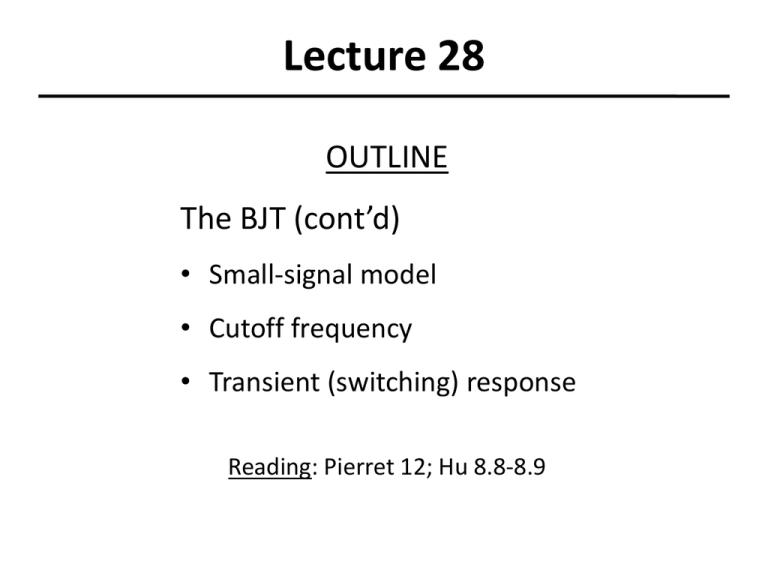
Lecture 28 OUTLINE The BJT (cont’d) • Small-signal model • Cutoff frequency • Transient (switching) response Reading: Pierret 12; Hu 8.8-8.9 Small-Signal Model Common-emitter configuration, forward-active mode: I C F I F 0 e qVBE / kT R. F. Pierret, Semiconductor Device Fundamentals, Fig.12.1(a) B C + “hybrid pi” BJT small signal model: C vbe E dI C IC d qVBE / kT gm F I F 0e dVBE dVBE kT / q EE130/230A Fall 2013 gm vbe E Transconductance: r Lecture 28, Slide 2 Small-Signal Model (cont.) gm 1 dI B 1 dI C r dVBE dc dVBE dc r dc gm C C J , BE C D , BE C D , BE CJ, BE A s Wdep, BE CD,BE dQF dVBE QF forward transit time F IC C D , BE EE130/230A Fall 2013 where QF is the magnitude of minority-carrier charge stored in the base and emitter regions d F I C F gm dVBE Lecture 28, Slide 3 Example A BJT is biased at IC = 1 mA and VCE = 3V. dc = 90, F = 5ps, T = 300K. Find (a) gm , (b) r , (c) C . Solution: (a) g m I C /( kT / q) 1 mA mA 39 39 mS (milli siemens) 26 mV V (b) r = dc / gm = 90/0.039 = 2.3 kW (c) C F g m 5 10 12 0.039 1.9 10 14 F 19 fF (femto farad) EE130/230A Fall 2013 Lecture 28, Slide 4 Cutoff Frequency, fT B ib ib vbe input admittance 1 / r jwC + C ic g m vbe (w ) C vbe r gm vbe E ic gm gm 1 / r jwC g m / dc jw F g m C J , BE ib 1 1 / dc jw F C J , BE kT / qI C The cutoff frequency is defined to be the frequency (f = w/2) at which the short-circuit a.c. current gain equals 1: ac 1 at fT EE130/230A Fall 2013 1 2 F CJ , BE kT / qI C Lecture 28, Slide 5 E For the full BJT equivalent circuit: 1 fT 2 F CJ , BE CJ , BC kT / qI C CJ , BC re rc fT is commonly used as a metric for the speed of a BJT. Si/SiGe HBT by IBM To maximize fT: • increase IC • minimize CJ,BE, CJ,BC • minimize re, rc • minimize F EE130/230A Fall 2013 Lecture 28, Slide 6 Base Widening at High IC: Kirk Effect For a NPN BJT: J C qnvsat dep,C qN C qn qN C JC vsat • At very high current densities (>0.5mA/mm2), the density of mobile charge passing through the collector depletion region exceeds the ionized dopant charge density: increasing IC The base width (W) is effectively increased (referred to as “base push out”) F increases and hence fT decreases. •This effect can be avoided by increasing NC increased CJ,BC , decreased VCE0 EE130/230A Fall 2013 Lecture 28, Slide 7 C. C. Hu, Modern Semiconductor Devices for Integrated Circuits, Figure 8-18 Summary: BJT Small Signal Model Hybrid pi model for the common-emitter configuration, forward-active mode: B C + C vbe r gm vbe E E r dc gm gm C C J , BE F g m EE130/230A Fall 2013 Lecture 28, Slide 8 IC kT / q BJT Switching - Qualitative R. F. Pierret, Semiconductor Device Fundamentals, Figs. 12.3-12.4 EE130/230A Fall 2013 Lecture 28, Slide 9 Turn-on Transient Response dQB QB I BB dt B where IBB=VS/RS •The general solution is: QB (t ) I BB B Aet / B •Initial condition: QB(0)=0 since transistor is in cutoff QB (t ) I BB B (1 e t / B ) QB (t ) I BB B 1 e t / B 0 t tr t iC (t ) t VCC t t r RL EE130/230A Fall 2013 Lecture 28, Slide 10 1 t r B ln VCC / RL 1 I BB B R. F. Pierret, Semiconductor Device Fundamentals, Fig. 12.5 Turn-off Transient Response dQB Q I BB B dt B • The general solution is: QB (t ) I BB B Aet / B • Initial condition: QB(0)=IBBB QB (t ) I BB B 1 et / B 1 t sd B ln I CC t I BB B I CC 0 t t sd iC (t ) t / B Q ( t ) I 1 e B BB B t t sd t t EE130/230A Fall 2013 Lecture 28, Slide 11 R. F. Pierret, Semiconductor Device Fundamentals, Fig. 12.5 Reducing B for Faster Turn-Off • The speed at which a BJT is turned off is dependent on the amount of excess minority-carrier charge stored in the base, QB, and also the recombination lifetime, B. – By reducing B, the carrier removal rate is increased Example: Add recombination centers (Au atoms) in the base EE130/230A Fall 2013 Lecture 28, Slide 12 Schottky-Clamped BJT • When the BJT enters the saturation mode, the Schottky diode begins to conduct and “clamps” the C-B junction voltage at a relatively low positive value. reduced stored charge in quasi-neutral base EE130/230A Fall 2013 Lecture 28, Slide 13 R. F. Pierret, Semiconductor Device Fundamentals, Fig. 12.7
